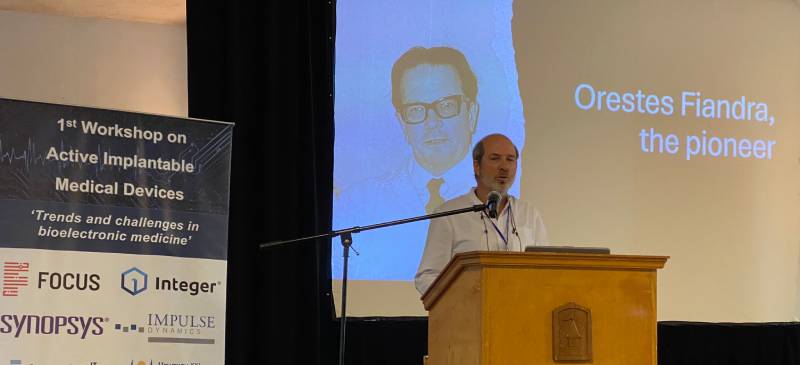- Home
- About us
- News
- Events
- EXPORT Export
-
BUY
Buy
Buy
- INVEST Invest
- COUNTRY BRAND Country Brand
-
INFORMATION CENTER
Information center
InformationCenterInformationCenterReports Country reports Department reports Foreign trade reports Product-Destination worksheet Sectors reports Work documentsStatistical information Classification Uruguay XXI Exports Imports Innovative National Effort Macroeconomic Monitor Tools Buyers Exporters Investors
- Contact
-
Languages
Uruguay Emerges as a Leader in Implantable Medical Device Innovation
Thanks to its forward-thinking approach and the exceptional talent of its professionals, the country is making significant strides on the global stage, transforming the landscape of advanced medical technologies
Share:

Uruguay is writing a new chapter in the implantable medical technology sector, building on a solid foundation of innovation and technical expertise that began to consolidate several decades ago.
With a pioneering history marked by significant developments such as pacemakers in the 1960s, the country became a core of excellence in the medical industry.
The forerunner in this field was Uruguayan doctor Orestes Fiandra, who performed the world’s first successful implantation of a long-life pacemaker, laying the foundation for what would eventually become the Cardiostimulator Construction Center (CCC). The Uruguayan company dominated the local market and expanded internationally, providing services to various companies in the sector and becoming a name of reference. In 2014, it was acquired by foreign investors and is currently part of the US Integer Holdings Corporation.
With this legacy, Uruguay demonstrated its ability to lead in medical innovation and its potential to foster and expand new companies. “Uruguay has earned a name in the world in this field, and if you say you are going to work in Uruguay, it is well received because they understand that there are people here with the knowledge to do it,” Pedro Arzuaga, the director of the Montevideo office of the multinational Impulse Dynamics, dedicated exclusively to product development, commented to Uruguay XXI.
In this promising context, Punta del Este was the setting for the first Active Implantable Medical Devices Workshop, organized within the framework of IEEE LASCAS 2024. The event, which brought together more than 100 international participants, including students, industry professionals, and key stakeholders from several countries, showcased diverse presentations on active implant applications, such as spinal cord stimulation, heart failure, and bioelectronic medicine.
The meeting was also a platform to discuss how collaboration between academia and industry can accelerate the development of new technologies in the country. Several industry players highlighted that Uruguay could leverage its history of innovation and highly educated workforce to further expand its impact on the global market for these types of technologies.
Uruguayan Marcelo Barú, Innovation Leader at Biotronik Neuro - a German-based multinational - provided an overview of spinal cord stimulation during the event and praised Uruguayan talent’s professionalism.
“I have worked with engineers from all over the world, and the Uruguayan engineer can see the ‘big picture,’ added to the years of experience in medical devices that Uruguay has,” said the expert, who has some 30 years of experience designing implantable medical devices.
Uruguayan innovation is the focus of international companies
At the forefront of medical innovation, Uruguay managed to position itself as a relevant player in the development of implantable medical devices, attracting international companies such as Integer Holdings Corporation, Focus, and Impulse Dynamics that seek to take advantage of the country’s local talent and innovation capacity.
Pedro Arzuaga, director of Impulse Dynamics’ Montevideo office, said that its Uruguay team consists of 19 workers, 17 of whom are engineers.
“We are dedicated exclusively to product development,” he explained. This specialization underlines the highly qualified and innovative approach that characterizes the Uruguayan operation.
Impulse Dynamics’ CTO and executive VP, David Prutchi, who leads the project from New Jersey, USA, highlighted the importance of Uruguay in the company’s global structure. “We have many more engineers in Uruguay than in the United States,” he said.
The relationship with CCC was fundamental to the establishment and success of Impulse Dynamics in the country. Prutchi recounted how they began their collaboration. “An Argentine physician told me about CCC in 1998, and shortly after that, we started working on a device that was not for our primary therapy, but that soon led us to develop technology for heart failure,” he said.
This initial collaboration paved the way for more ambitious projects that have met rigorous international standards. Looking to the future, Arzuaga highlighted Uruguay’s potential as a center of excellence in the medical industry. “Uruguay has a name in the world. There are people here with the knowledge to do great things in the medical technology field,” he noted.
This positive global perception is a catalyst that continues to attract international projects and collaborations to the country. With a focus on collaboration, human quality, and continuous innovation, Uruguay is well-positioned to continue to be a leader in developing these life-transforming medical technologies. “This started as something from a single, very tiny company, CCC, which grew. That was very important, but now other companies are emerging in the country that are also developing,” said Arzuaga, adding that there is an opportunity for large foreign companies developing implantable devices to come to Uruguay and take advantage of the talent.
In this regard, Prutchi said: “I have worked with engineers in many parts of the world, and here in Uruguay, the education of engineers is at a higher level.”
FEATURED NEWS:
- Uruguayan Startup Nanogrow Crowned Most Disruptive Company at South Summit Brazil
- Uruguay strengthens its regional leadership in pharmaceutical logistics with a standout presence at Logipharma 2025
- Uruguay stood out at South Summit Brazil with the most disruptive startup and strengthened its position as a business and innovation hub in Latin America
